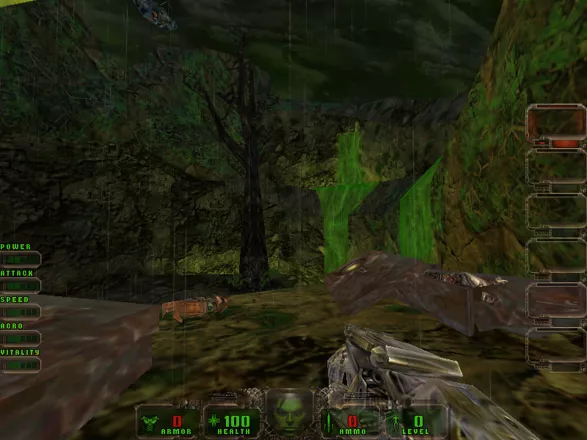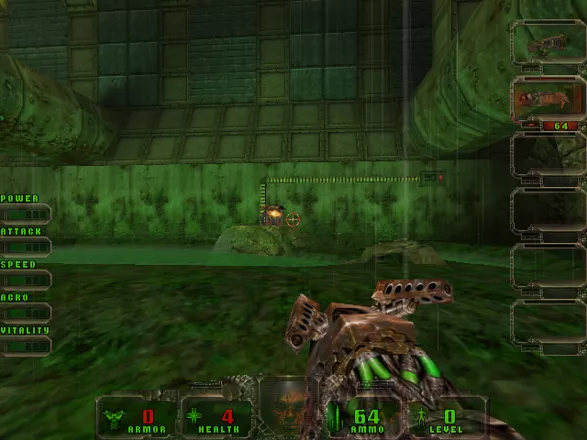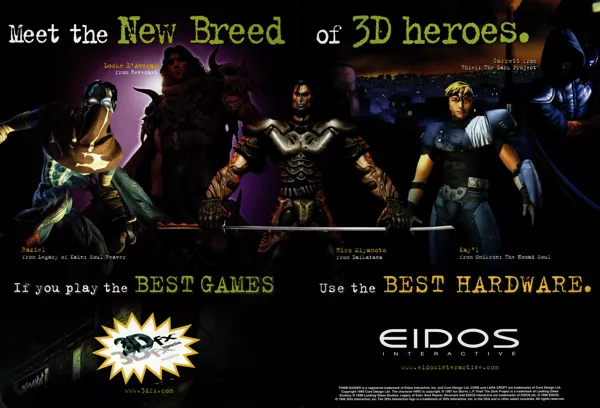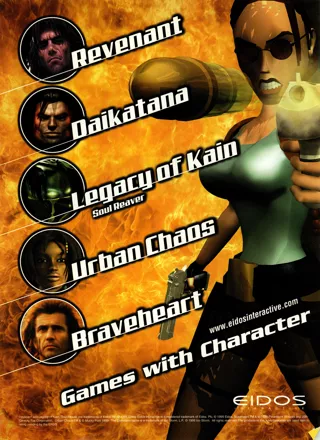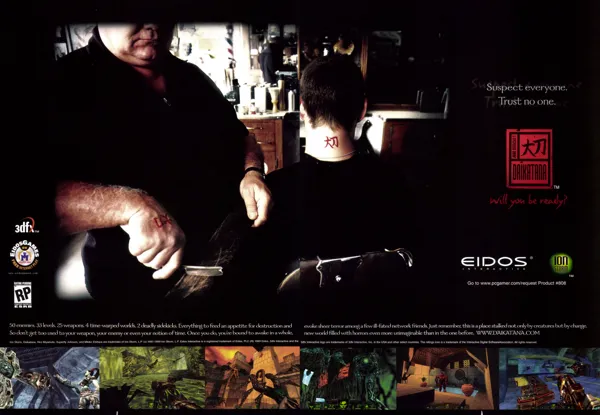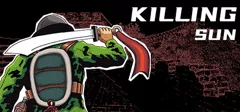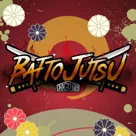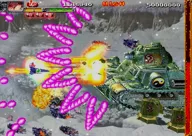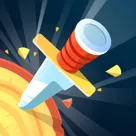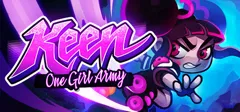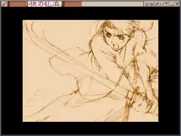John Romero's Daikatana
-
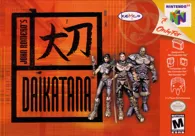 John Romero's Daikatana
(2000 on
Nintendo 64)
John Romero's Daikatana
(2000 on
Nintendo 64)
-
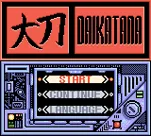 John Romero's Daikatana
(2000 on
Game Boy Color)
John Romero's Daikatana
(2000 on
Game Boy Color)
Description official descriptions
Hiro Miyamoto is a martial arts instructor and a member of an ancient clan of fighters. One day he learns that Kage Mishima, a sworn enemy of his clan, has gained possession of the Daikatana, a magical sword that allows its bearer to travel through time. As a result of Mishima's quest for power, a devastating disease is threatening humanity. Hiro and his friends must venture into different time periods, retrieve the sword, and defeat Mishima.
Daikatana is a first-person shooter using the Quake II engine. The game is divided into four episodes of several levels each, each episode taking place in a different time period: far-future Japan, ancient Greece, Dark Ages Norway, and near-future USA. The game uses cutscenes and text to tell the story. Two AI-controlled characters accompany Hiro throughout the quest, helping him in battles and also requiring protection. In addition to several different firearms, the Daikatana itself, which the player acquires in Episode 2, can gain experience and grow stronger as it is used. The game includes a multi-player deathmatch mode.
Spellings
- 大刀 - Japanese spelling
Groups +
Screenshots
Promos
Videos
Add Trailer or Gameplay Video +1 point
See any errors or missing info for this game?
You can submit a correction, contribute trivia, add to a game group, add a related site or alternate title.
Credits (Windows version)
165 People (140 developers, 25 thanks) · View all
| Lead Design | |
| Producer | |
| Lead Programmer | |
| Programming | |
| Level Designer | |
| Localisation Lead | |
| Script | |
| Art Director | |
| Lead Artist | |
| Artist | |
| Package Design | |
| Sound Director | |
| [ full credits ] | |
Reviews
Critics
Average score: 57% (based on 49 ratings)
Players
Average score: 2.6 out of 5 (based on 83 ratings with 12 reviews)
A deeply troubled effort that hints at greatness
The Good
I like most other people who followed PC gaming at the time was waiting for Daikatana with bated breath. It was to be John Romero's crowning achievement; indeed the misfired media blitz that Eidos launched in which Romero indirectly proclaimed us to all be his 'bitches' smacked of rockstar-esque confidence and bravado. By its release, the media and consumers alike were chomping at the bit to find every single flaw they could find and try and tear Romero's baby (and ego) to pieces; and indeed, they found many flaws. But not all of it is justified, and with the benefit of hindsight perhaps it's time to sit down and take this piece for what it is.
There is a lot to like about Daikatana. The idea of having a squad of sidekicks to accompany you most of the way through the game was new and original among FPSes of the day, and for all the flak they get, I applaud Ion Storm's steadfast insistence on their inclusion. It's one of the many things that sets Daikatana apart from any FPS before and to a degree, since.
People have criticised this game in the past for its use of the Quake 2 engine, which even in the year 2000 was already showing seams, but I really have no complaints about it here. Ion Storm did not just use it stock; volumetric fog, alpha transparency, weather effects, enhanced particles, decals and animated skyboxes have all been integrated seamlessly and make the title much more visually interesting than its Quake 2 engine moniker would have you believe from the outset. Texture detail is low (lower than that of Unreal, which preceded it by two years), but the artwork itself is varied and well enough defined that I have no problem overlooking that.
Daikatana features plenty of variety; the weapons are hugely varied and plentiful, as well as enemies. The stark contrast between the different time periods is fantastic, and the two middle chapters are pulled off beautifully.
Ancient Greece feels fresh, colourful and enchanting. Chopping down spiders and arachnids with your sword is a fun experience the first time around, and some of the decoration is good enough that even in the current day of games, you can still stop and admire the creativity and detail that went into the place. Medieval Norway is a work of frostbitten beauty, and complemented by Will Loconto's soundtrack which sets the scene perfectly. The slow falling of snow, the rolling clouds, frozen rivers and quaint medieval huts all lend to an immersive, almost romantic mood. These are without doubt the best parts of the game, rivaling its competitor of the time, Unreal, for the most beautiful vistas ever experienced in an FPS game.
The weapons, even when you know they're filling bog-standard FPS roles, are all highly creative (albeit grievously unbalanced -- I'll get to that below) and it's obvious that Ion Storm have worked hard to differentiate Daikatana from the average space-marine-killing-aliens-with-a-shotgun mould. The discus of Daedalus in the Greek episode, the shotcycler in the Japan episode and Norway's ballista were all one-of-a-kind implementations of weaponry, and a joy to use.
And finally, it's subtle, but when you're getting around, Daikatana just feels good. From the weapon and view bobbing, footsteps and the sounds as Hiro is running and jumping all over the shop lends a sense of urgency and complement the game's fast pace nicely. The audio is superb; weapons sound meaty and the ambience is of a high standard. (on that note, those who've played Daikatana's far superior sister title Deus Ex, will notice that the two projects actually appear to have borrowed sound assets from each other fairly liberally.)
The Bad
Unfortunately, for all of its great ideas, and despite its insane development cycle, Daikatana still manages to come off as a severely undercooked product. Most obvious, is that the weapons are highly unbalanced. Upon retrieving the game's eponymous sword you'll actually find very little use for any of the other weapons. The developers appear to have tried to compensate for this by making most of the other weapons totally, ridiculously powerful; most of the time that meant for me, I actually had no idea what most of the weapons were like until I decided to pull them out for boss fights, and upon doing so the boss in question was vapourised almost instantaneously. Compounding the problem of the Daikatana itself, is that the sword, as it gains power through the game, starts taking on so many flashy pyrotechnic effects that you literally cannot see where the hell you are going while you are toting it.
The whole presence of your buddies in the game, if a noble concept, is annoying in practice; not just their AI, which has been sufficiently lambasted in numerous other reviews, but also just their general demeanour. Both Mikiko and Superfly come off as thoroughly unlikeable douchebags, and indeed my only motivation to keep them alive at all was the fact that you cannot complete a level without them alive and standing next to you at the exit.
The cutscene dialogue between all characters is hilariously bad and no one has any real backstory asides a totally perfunctory and contrived motivation for wanting to save take over the world. Indeed, the game's evil overlord Mishima seems to have absolutely no reason to enslave the earth except for 'because I can' and Hiro literally takes on the quest to stop him for no reason other than the fact that a random old guy came to his door and asked him to. I'm not expecting Academy Award-winning performances and storyline from an action game, but the cutscenes are generally quite long and I'm left wondering why they even bothered at all if they're not going to explain a bloody thing.
Your AI sidekicks frequently get stuck on corners, ladders, each other and basically anything that is not a straight, empty corridor. To add insult to injury, they've been given just enough character to express annoyance at your babysitting, but not enough brains to take care of themselves.
When Mikiko gets stuck in an infinite loop of her climbing animation at the bottom of a ladder, I have no choice but to displace her myself by shoving her out off of the ladder. "Stop pushing me around!", she says. There is nary a 'thankyou' or 'sorry' to be heard anywhere in the game when you actually try to stick up for your buddies. In fact, there is never any point in which any single character shows any sign of humility, vulnerability or indeed any kind of emotion at all other than tough-guy bravado -- further lending to your dislike of them when you have to leave them for a few minutes while you crawl up a vent to open a door, and the game ends halfway through because they stood stock still while a trio of mosquitoes and frogs nibble at their toes 'till they die. These are by no means isolated incidents and will be the first thing that drives you away from the game.
Another thing is the first and last chapters, which are not only too similar to each other, but also extremely drab and boring to play through, and full of elementary design mistakes. Hunting from level to level for hours on end looking for a keycard or cog to put into a machine is not fun. Walking down the hallway only to have the ground explode under you without warning and throw you into a pit of deadly spikes is not fun. In one of the Norway levels I spent something like three hours searching for a freaking key for a door and it was only after getting bored out of my mind and hitting things randomly with the sword that I found the ice on the surface of a fountain was breakable and the key was hidden in the water that I could continue. Why did the game provide absolutely no clue to this? Why couldn't one of the characters say "Hey Hiro, maybe you can break the ice there?" Why didn't they make the ice transparent or put a crack in it, indicating it could be shattered? These kinds of oversights are glaring, infuriating, and frequent.
The Bottom Line
Overall, this game is a moderately satisfying product, spearheaded by a passionate and visionary face of the gaming industry, that is dogged by a great many problems; to some, those problems will be too severe and too frequent to enjoy the effort that has gone into it. Those of us who are more patient may be able to extract some quality entertainment that is buried beneath its failings. For sure, this game did not live up to the hype surrounding it.
Ultimately I'm convinced that the biggest problem with this game was simply its timing. Released earlier, before 2000, in a world of lower standards, it may have fared better as people could more readily embrace its creative and original and gameplay mechanics. Released later, perhaps folks could glossed over its use of the aging Quake 2 tech that constitutes its base, and enjoyed a highly solid FPS with a unique aesthetic and personality.
As it stands, it's caught in somewhat of a no-man's land, nowhere close to where it needs to be either way, and suffers greatly for it -- ironic, given the game's running theme of time travel. Approach it with an open heart and an open mind, however, and you will find enough meat on this title to keep you satisfied.
Windows · by Ian McLean (10) · 2009
The Good
One surprising thing about Daikatana is that it genuinely should have been really, really good. Just look at its premise: an immersive first-person action game centered around time travel where every chapter has a unique feel and playstyle to it. It's unique, visionary, unprecedented, and at the same time absolutely doable with technology available at the time.
And that overall concept is still the game's biggest strength. The varied locations, distinct aesthetics, and differently paced levels all add to Daikatana's feeling of freshness. It doesn't really matter how flimsy and clichéd its excuse of a story is with a general premise this good.
Another thing Daikatana gets mostly right that's really important for an action game is the combat. Thanks to the varied time periods and aesthetics, each chapter has a separate and distinct arsenal, not restrained by the somewhat basic futurism of Quake II or the realism of Half-Life. Not every weapon is all that useful or satisfying to use, but the variety is enough to allow for freedom when it comes to playstyle and adapting to the game's challenges. Another interesting addition is the titular daikatana, a melee weapon that gets stronger with every enemy you kill with it, as opposed to being bound to the XP system like the other weapons.
The Bad
With so many good things about Daikatana, why is it not a good game overall? One reason is the level design. While not more convoluted than that of Doom or Quake (let alone some maps in Unreal), it definitely feels far less intuitive and at some points simply annoying. On top of that, chapters 1 and 4 really like to put enemies with hitscan weapons or very fast projectiles in places where they will see you immediately as you enter a room, often not allowing any time to properly dodge. Combined with an abundance of segments where you actually have to take (mostly fall) damage to progress, Daikatana feels a bit like a throwback to the NES era of artificial difficulty. Except here it's used simply to spite the player and not to pad the game's length despite technical limitations.
But Daikatana's biggest sin lies somewhere else - the infamous AI ally system. During large portions of the game you'll have 1 or 2 NPCs following you, with them being by your side necessary to move on to the next part of a level. A combination of friendly fire, awkward hitboxes, and most of all absolutely abysmal pathfinding makes the allies a waking nightmare that will impede your progress on numerous occasions in the most frustrating ways possible.
Despite Daikatana's notoriously long development cycle, you can tell the quality assurance portion of it was rushed. The game is mostly a finished product and definitely playable, but it does have its fair share of minor hiccups and annoyances surrounding hitboxes and collisions.
The Bottom Line
In short, Daikatana is a both unique and highly frustrating experience that doesn't quite live down to its terrible reputation, but is even farther from living up to the promise of its premise. 4/10
Windows · by Pegarange (296) · 2023
A challenging FPS, and I'm having fun with it.
The Good
I believe the strongest point of this game is the fact that it almost appears to be 4 different games in one box. There are four different time periods which feature different foes, weapons, maps and design. If you don't like one, play on, because the next one will be completely different. The levels feature many hidden areas reminicent of Doom and Quake 1. I believe the graphics to be good and framerates to be good as well (p2-450, 128 ram, w/Voodoo 3000). Background music is good to very good in areas. Medusa level music really added to the atmosphere. Also there is actually a story that goes along with the game as it progresses, which many FPS lack, that adds to the experience.
The Bad
Savegem crystal system requires you to have picked up a crystal to save the game. Crystals can be accumulated, but it will force numerous replays on some areas that you would prefer to be done with. Some bugs in the sidekick A.I., as has been mentioned, being killed in closed doors, if you tell them to "get" something that is out of reach, they will continue the attempt even after being recalled. Manually configuring voodoo card support.
The Bottom Line
This is a game that was originally created and was supposed to be released sometime shortly after Quake 2 was. Many problems forced numerous delays This game has received a lot of publicity and many had very high expectations of it. It took a very long time to produce and anyone interested can read a good story about it on gamespot. Many have developed a personal dislike for some of the people involved due to some of the publicity practices (slogans) released through the years, as well as other reasons. If you are expecting Unreal or Quake 3 graphics, then you don't understand what all this game has been through and need to understand the delays involved. Graphics are better than Quake 2. If you like FPS and don't have any pre-concieved notions about the game, and have some patience, you probably will like the game. A patch is soon to be released that will address many of the (constructive) complaints made about the game.
Windows · by Mr. Natural (2) · 2000
Discussion
| Subject | By | Date |
|---|---|---|
| Should I try it? | Unicorn Lynx (181780) | Dec 30, 2011 |
| incite PC gaming's Daikatana preview / interview video | Foxhack (32100) | Aug 19, 2007 |
Trivia
Advertisement
Long before Daikatana was released, an ad for it was run in several magazines stating "John Romero's Gonna Make You His Bitch." Needless to say this upset quite a few folks.
Daikatana Deathmatch
In April 2007, a fan team released Daikatana Deathmatch (DKDM), a multiplayer-only modification stripping the game from all the single player parts to reduce the file size for players who only want the multiplayer part. It still requires a full copy of the game to play. The link can be found in the related links section.
Development
Daikatana was in development for 3 years, exactly. The reason for the long development cycle was the switch to the Quake II engine. Romero decided to switch because of its colored lighting, among other graphical goodies, but when he finally received the source code, it was nothing like he pictured. Overall the story of the game's development and Ion Storm in general is as epic and profound as anything in the game. Check the related links for The Story of Daikatana.
Dialogue
The characters' sound files used in this game are not encrypted in any way. They're ordinary mp3 files which can be found in the data/sounds/voices folder of the Daikatana directory. There's quite a bit of unused dialogue in there which never made it into the full game. It seems the enemies and the player's two sidekicks were supposed to have more ambient dialogue (e.g. combat taunts, waiting sounds) than what was eventually used.
Dopefish
There are four Dopefish hidden in the game, one per time period.
German Windows version
In the German version enemy blood was colored grey, gore effects were removed and various human enemy modes changed, e.g. into robots or with an added mask to hide their face. A detailed list of changes can be found on schnittberichte.com (German).
Nintendo 64 version
The Nintendo 64 version misses violence in comparison to the original Windows version, e.g. purple instead of red blood. The PAL version was even cut further: the blood was replaced with sparks and civilians are immortal.
References
In the lobby of the Mishima Funeral Home/Crematorium, there's some solemn funeral-type music playing. This is really a slowed down version of the famous e1m1 music from DOOM.
Remix
As the sounds and dialog are not encrypted, one creative mixer was able to rearrange the dialog, add a little fake stuff here and there, add some bump-and-grind music, and came up with a long MP3 that sounds as if the two guys in the game were "engaging" the female sidekick. Computer Gaming World called it "the ONLY redeeming feature of Daikatana".
Sales
Daikatana sold 200,000 copies and had budget of over $10 million.
Awards
- Computer Gaming World
- April 2001 (Issue #201) – Coaster of the Year
- PC Powerplay (Germany)
- Issue 03/2005 - #8 Biggest Disappointment
- Issue 02/2006 - #7 Hype Disappointment
Information also contributed by Alan Chan, bkaradzic, Kalirion, Kasey Chang, Sciere, WildKard and Zack Green.
Analytics
Upgrade to MobyPro to view research rankings!
Related Sites +
-
Daikatana Deathmatch
A modification that strips the game from all the singleplayer content, to reduce the file size for multiplayer-only. It still requires a full copy of the game to play. -
Daikatana News
Daikatana news and info -
Daikatana v1.3 Unofficial Patch
Unofficial patch which fixes many bugs and adds new features. -
Matt Chat 55
Video interview with John Romero about the development of John Romero's Daikatana -
Planet Daikatana
Contains news, articles, FAQ, and media -
Something Awful review
A humorous review on Something Awful (PC demo) -
The story of Daikatana
From Gamespot: This Behind the Games feature gives us the inside look at Daikatana and the tragedies and triumphs behind one of the most talked about games in history. -
Wikipedia: John Romero's Daikatana
Information about John Romero's Daikatana at Wikipedia
Identifiers +
Contribute
Are you familiar with this game? Help document and preserve this entry in video game history! If your contribution is approved, you will earn points and be credited as a contributor.
Contributors to this Entry
Game added by Matthew Bailey.
Additional contributors: Trixter, Andrew Hartnett, John Romero, Sciere, Ms. Tea, DreinIX, Cantillon, Patrick Bregger, Frank Sapone, aKro.
Game added June 18, 2000. Last modified April 2, 2024.



